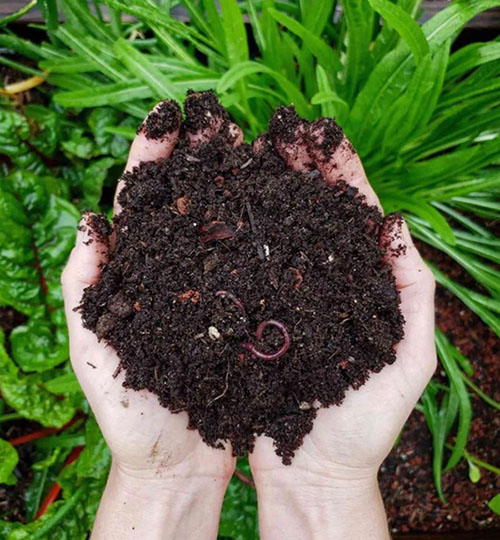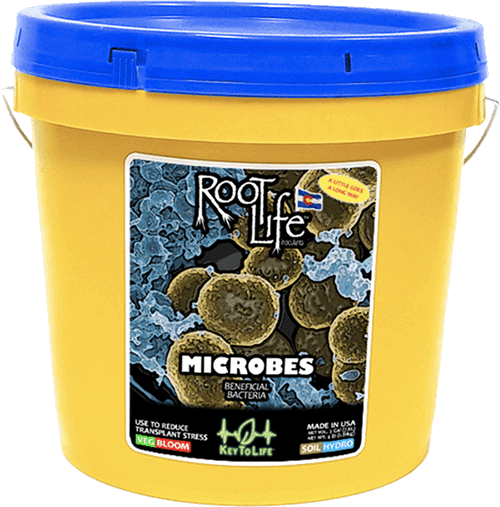What makes Happy Trees happier than any other trees? We study science, pursue the best practices, and do everything within our power to make sure that your trees have everything they need to get off to a happy, healthy start.
Every Happy Tree is fed and fertilized in three crucial ways, structurally, minerally, and biologically. Like us, trees need nutrients in order to perform complex functions such as photosynthesis, which uses energy from the sun to convert water and carbon dioxide into sugars that feed the plant.

 Compost
Compost
Compost - compost is simply decayed organic matter rich in nutrients and byproducts of bacterial and fungal digestion. Microbes feed on organic matter, often sheep, poultry, or steer manure mixed with leaf litter and other debris. They break down complex compounds into simple nutrients that the plants take up as food. Happy Trees mixes about 1/3 compost into the soil we excavated from the planting hole, thus breaking up heavy clay and binding sandy soil together. Compost allows water to penetrate deeply into the root zone in clay soil, while sponging up and storing water in sandy soils. It allows roots to plunge into amended soil with less resistance as they extract moisture and minerals from the enriched media.
Minerals - Just as you likely take a multi-vitamin to assist with metabolism, trees need many of the same minerals and vitamins to lift their leaves to colossal heights! Happy Trees partners with a local Colorado company, Key to Life, to feed our trees with Green9. Green9 is a micronutrient composition specifically formulated for our soils along Colorado's Front Range.
Key among the micronutrients to support trees is iron, the same element that holds up our bridges and skyscrapers. Iron is a major building block of chlorophyll at the cellular level. Chlorophyll is responsible for photosynthesis, the process that converts sunlight into sugars and other nutrients.
Iron gives leaves their vibrant green color. Iron is abundant in our soils but often in a form chemically unavailable for plant uptake. When plants are unable to extract iron from the soil, they can't manufacture chlorophyll. Without chlorophyll, the plants can't produce the food they need to survive. The leaves turn yellow, weakening the plant until it eventually dies.
Green9 also supplies magnesium, sodium, zinc, manganese, copper, boron, and molybdenum, similar to what you might see on the label of a bottle of Centrum, but in a composition readily available for plant uptake. These micronutrients support vital cellular functions ensuring your trees have every tool necessary to build healthy tissue, strong wood, abundant leaves, vigorous roots, and prolific flowers.
Total Nitrogen (N) 6% 0.48% Water Insoluble Nitrogen 5.52% Water Soluble Nitrogen Derived From: Non-GMO Soy Protein Hydrolysate
Amino Acid Profile: L-Aspartic Acid,L-Isoleucine, L-Threonine, L-Leucine, L-Serine, L-Tyrosine, L-Glutamic Acid, L-Phenylalanine, L-Proline, L-Lysine, L-Alanine, L-Histidine, L-Cystine, L-Arginine, L-Valine, Glycine, L-Methionine
Micronutrient Profile: Magnesium (Mg) – 0.83%, Sodium (Na) – 9.8%, Iron (Fe) – 2.63%, Zinc (Zn) – 3.97%, Manganese (Mn) – 1.17%, Copper (Cu) – 1.51%, Boron (B) – 0.66%,Molybdenum (Mo) – 0.12%
Microbes - One of the most exciting advances in agricultural science in recent years is the introduction of live cultures of beneficial bacteria and fungi to our garden soil. Sounds gross, but these micro-organisms condition the soil and break down complex molecules into simple compounds that feed the trees.
We once thought of bacteria and fungi as pathogens detrimental to plant health. There are many harmful strains of bacteria and fungi to be sure, but we have only recently begun to realize that beneficial colonies of these microorganisms are not only good, but essential for feeding trees and transporting water and nutrients throughtout a living soil ecosystem. In fact, these "good microbes" may very well combat "bad microbes", protecting plants and preserving a balance of nature.
Would it surprise you to learn that upwards of 10% of your body mass* is not human but foreign bacteria, yeast, and fungi? Disgusting! Yet it turns out that without these alien interlopers we likely couldn't digest food and process nutrients into our bloodstream. Bacteria and fungi are essential for sustaining our bodies, and in turn are essential supporting higher life forms in natural forest ecosystems.
In the bayous of Louisiana or the rainforest of Washington State's Olympic Peninsula, millions of years of leaf litter have conditioned the soil with naturally ocurring compost supporting thousands of species of beneficial bacteria and fungi. Trillions of colonies of microbes perpetually consume deceased plants, returning nutrients to the soil, and assisting living plants with nutrient uptake. Toss an acorn into the air in Portland, Oregon, and it springs to life before it hits the ground!
In Colorado, no such luck. Our High Chaparral supports only coarse grasses, intermittent wildflowers, and the stray cactus. Our barren soil is devoid of the microbes trees need to extract nutrients from the soil and to transport water and minerals throughtout the root zone and upwards into the trunks of the trees. Incorporating live cultures of beneficial bacteria and fungi has proven invaluable for promoting plant health and establishment.
Active Ingredients: 79% Dextrose (microbial food & carrier)
1.00 x 10^8 (100,000,000) cfu/g each:
Bacillus firmus, B. amyloliquefaciens, B. subtilis, B. licheniformis, B. megaterium, B. pumilus, B. azotoformans, B. coagulans, Paenibacillus polymyxa, Paenibacillus durum
2.00 x 10^7 (20,000,000) cfu/g each:
Psuedomonas aureofaciens, Psuedomonas fluorescens, Streptomyces lydicus, Steptomyces griseus, Trichoderma reesei, Trichoderma harzianum
* At least 5.124 billion cfu/tsp. A cfu is a Colony Forming Unit.
Inert Ingredients: 21%
Almost none of the trees we are able to grow here actually belong here. Very few would survive a decade without supplemental water and fertilizer. Understanding what trees need to survive and providing them with the essential elements to support life is the key to helping Colorado trees thrive for generations to come.


